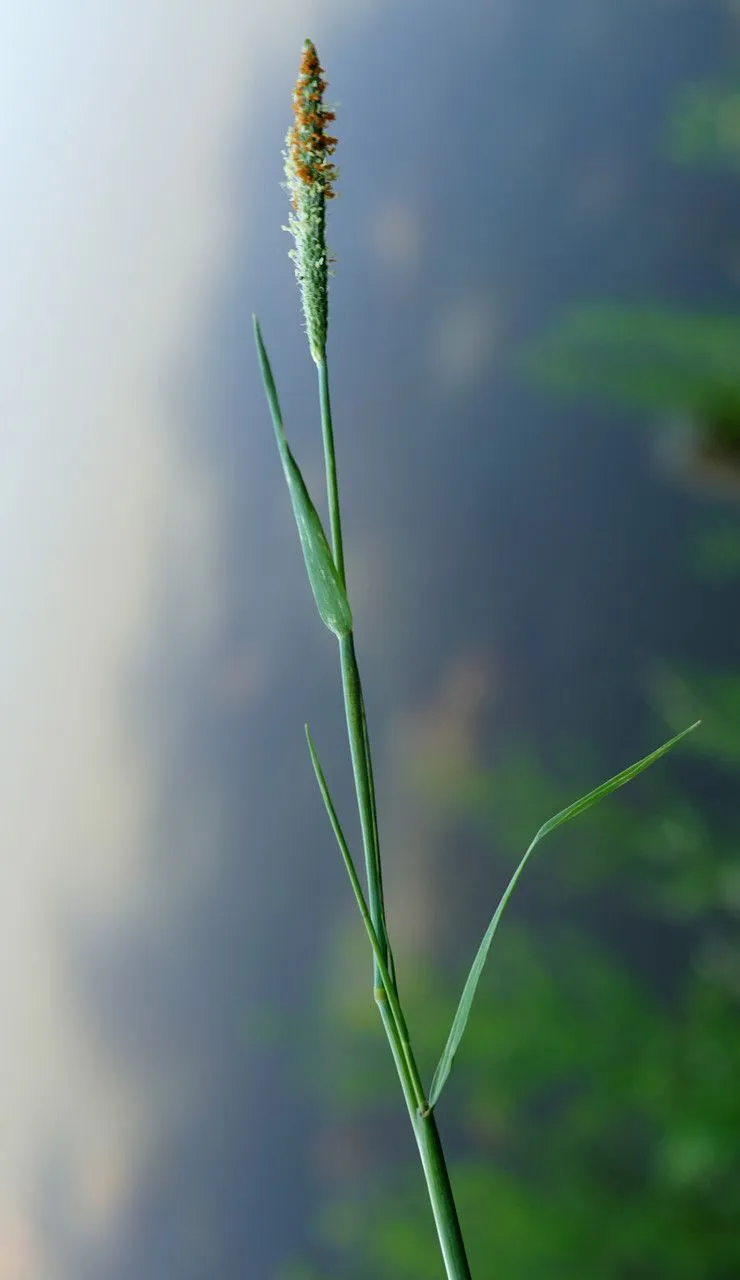
Author: Sobol.
Bibliography: Fl. Petrop.: 16 (1799)
Year: 1799
Status: accepted
Rank: species
Genus: Alopecurus
Vegetable: False
Observations: Temp. Northern Hemisphere to Andes
Orange foxtail, scientifically known as Alopecurus aequalis, is a species of grass that holds a prominent place in the family Poaceae. First described by Sobol. in the comprehensive botanical text “Fl. Petrop.” published in 1799, this grass has since been widely recognized for its distinctive characteristics and broad geographical presence.
This perennial grass is predominantly found throughout the temperate regions of the Northern Hemisphere, extending its reach as far south as the formidable Andes. The plant’s adaptability to various climates and elevations speaks to its robust nature and ecological versatility.
Characterized by its foxtail-like appearance, Alopecurus aequalis showcases dense, cylindrical flower spikes that resemble the tail of a fox, thereby earning its common name, Orange foxtail. These spikes are typically tinged with hues of orange, setting it apart visually from other species within the Poaceae family. The grass forms dense clumps that can stabilize the soil, making it an important species for erosion control in natural and man-made landscapes.
The Orange foxtail thrives in moist environments, often found in wetlands, alongside rivers, and in meadows that experience seasonal flooding. Its presence in these ecosystems plays a crucial role in maintaining the health and biodiversity of these habitats. By supporting a range of wildlife, from insects to larger herbivores, Alopecurus aequalis contributes to the intricate web of life in these regions.
Overall, the Orange foxtail is more than just a visually striking plant; it is a vital component of temperate northern and southern mountainous ecosystems. Its resilience and ecological contributions underscore the importance of conserving and studying this remarkable grass species.
Dan: gul rævehale
Eng: orange foxtail, short-awn foxtail, short-awned foxtail, little meadow foxtail, short foxtail, water foxtail
Deu: rostgelbe fuchsschwanz, rotgelbes fuchsschwanzgras, ziegelroter fuchsschwanz, rotgelber fuchschwanz
Fra: vulpin fauve, vulpin roux, vulpin à courtes arêtes, vulpin aristé
Swe: gulkavle, rantapuntarpää
Fin: rantapuntarpää
Nld: rosse vossenstaart
Nno: vassreverumpe
Nob: vassreverumpe
Sme: beatnatguppolsuoidni
Ita: coda di topo arrossata
Cym: cynffonwellt melyngoch, cynffonwellt y llyn
En: Orange foxtail, Short-awn foxtail, SHORT-AWN MEADOW-FOXTAIL, Shortawn foxtail, Short-awned foxtail, Little meadow foxtail, Short foxtail, Water foxtail
Da: Gul rævehale
Nl: Rosse vossenstaart
Fi: Rantapuntarpää
Fr: Vulpin fauve, Vulpin roux, Vulpin à courtes arêtes, Vulpin aristé
De: Rotgelber Fuchschwanz, Rostgelbe Fuchsschwanz, Rotgelbes Fuchsschwanzgras, Ziegelroter Fuchsschwanz, Roter Fuchsschwanz, Rotgelber Fuchsschwanz
It: Coda di Topo Arrossata
Se: Beatnatguppolsuoidni
Nb: Vassreverumpe
Nn: Vassreverumpe
Pt-br: Capim-rabo-de-rabosa-laranja
Sv: Gulkavle, Rantapuntarpää
Cy: Cynffonwellt Melyngoch, Cynffonwellt y Llyn
© copyright of the Board of Trustees of the Royal Botanic Gardens, Kew.
© copyright of the Board of Trustees of the Royal Botanic Gardens, Kew.
© copyright of the Board of Trustees of the Royal Botanic Gardens, Kew.
Taken May 12, 2021 by Luka Šuker (cc-by-sa)
Taken Jun 9, 2018 by Tela Botanica − Liliane ROUBAUDI (cc-by-sa)
Taken Jun 9, 2018 by Tela Botanica − Liliane ROUBAUDI (cc-by-sa)
Taken Jun 9, 2018 by Tela Botanica − Liliane ROUBAUDI (cc-by-sa)
Taken Jun 9, 2018 by Tela Botanica − Liliane ROUBAUDI (cc-by-sa)
Taken Jan 1, 1900 by EOL − John Hilty (cc-by-nc)
Taken May 25, 2008 by EOL − Michael Wunderli (cc-by)
Taken May 27, 2011 by Tela Botanica − Hugues TINGUY (cc-by-sa)
Taken Jun 9, 2018 by Tela Botanica − Liliane ROUBAUDI (cc-by-sa)
Taken Jun 9, 2018 by Tela Botanica − Liliane ROUBAUDI (cc-by-sa)
Taken Jun 17, 2020 by solator (cc-by-sa)
Taken Jan 1, 1900 by EOL − Encyclopedia of Life (cc-by-nc)
Taken Jan 1, 1900 by EOL − Encyclopedia of Life (cc-by-nc)
Taken Jan 1, 1900 by EOL − Encyclopedia of Life (cc-by-nc)
Taken Sep 25, 2014 by Tela Botanica − Jean-Claude ECHARDOUR (cc-by-sa)
Taken May 18, 2021 by Chlad Martin (cc-by-sa)
Taken Jan 1, 1900 by EOL − Encyclopedia of Life (cc-by-nc)
Taken Aug 15, 2005 by Photoflora – Benoit BOCK (©)
Taken Jul 15, 2005 by Photoflora – Benoit BOCK (©)
Taken Jul 15, 2005 by Photoflora – Benoit BOCK (©)
Taken Sep 25, 2014 by Tela Botanica − Jean-Claude ECHARDOUR (cc-by-sa)
Taken Sep 25, 2014 by Tela Botanica − Jean-Claude ECHARDOUR (cc-by-sa)
Taken Jan 1, 1970 by Photoflora – L’Abbé COSTE (©)
Taken Aug 30, 2017 by Tela Botanica − Martin FARGEAT (cc-by-sa)
Taken Jun 30, 1852 by Tela Botanica − Herbier PONTARLIER-MARICHAL (cc-by-sa)
Growth form: Bunch
Growth habit: Graminoid
Growth rate: Moderate
Ph maximum: 8.0
Ph minimum: 5.5
Light: 8
Atmospheric humidity: 9
Bloom months: [‘may’, ‘jun’, ‘jul’, ‘aug’, ‘sep’]
Soil nutriments: 5
Family: Myrtaceae Author: (F.Muell.) K.D.Hill & L.A.S.Johnson Bibliography: Telopea 6: 402 (1995) Year: 1995 Status:…
Family: Rubiaceae Author: Pierre ex A.Froehner Bibliography: Notizbl. Bot. Gart. Berlin-Dahlem 1: 237 (1897) Year:…
Family: Sapindaceae Author: Koidz. Bibliography: J. Coll. Sci. Imp. Univ. Tokyo 32(1): 38 (1911) Year:…
Family: Asteraceae Author: A.Gray Bibliography: Pacif. Railr. Rep.: 107 (1857) Year: 1857 Status: accepted Rank:…
Family: Fabaceae Author: Medik. Bibliography: Vorles. Churpfälz. Phys.-Ökon. Ges. 2: 398 (1787) Year: 1787 Status:…
Family: Aspleniaceae Author: (Cav.) Alston Bibliography: Bull. Misc. Inform. Kew 1932: 309 (1932) Year: 1932…